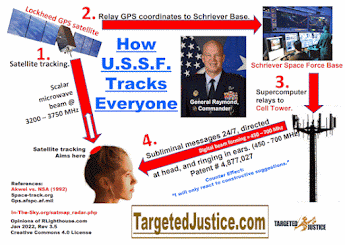Patent No. 5331969 Equipment for testing or measuring brain activity
Patent No. 5331969
Equipment for testing or measuring brain activity (Silberstein, Jul 26, 1994)
Abstract
Electrical activity of the brain is analysed by the application of a repetitive stimulus so as to evoke a steady state response, changes or differences in the steady state response being used as a measure of said electrical activity. The spatial distribution of the activity can be displayed as a topographical representation of the brain, which representation can be updated so as to provide a substantially real-time display. A neuro-psychiatric workstation incorporating such a display can be used for instance for various research purposes.
Notes:
This application is a continuation-in-part of co-pending application Ser. No. 07/035,610 entitled "Electroencephalographic Attention Monitor", filed Mar. 30, 1987, now U.S. Pat. No. 4,955,388.
BACKGROUND
OF THE INVENTION
1. Field of the Invention
The present invention relates to equipment for testing or measuring brain activity,
and may take the form of a neuropsychiatric workstation.
2. Description of the Prior Art
Please note the following discussion makes reference to publications which are
detailed subsequently under the heading "Reference Publications".
Numerous studies have been undertaken into the effects of cognition on Event
Related Potentials (ERPs) (see review Gevins and Cutillo 1986). The majority
of these studies have utilized discrete and discontinuous stimuli such as auditory
clicks, tones or the tachistoscopic presentation of visual targets. These stimuli
are associated with what have been termed "transient" ERPs (Regan 1977) and
constitute the familiar sequence of waveforms widely reported (e.g. McGillen
& Aunon 1987) . By contrast there have been relatively few reported studies
concerning cognitive effects on the evoked potentials associated with rapidly
repetitive stimuli. Potentials evoked by such stimuli have been termed "Steady
State Evoked Potentials" and consist of sinusoidal components at the stimulus
frequency or multiples of the stimulus frequency (Regan 1977, 1989).
The Steady Stare Potential has an attractive feature relevant to the study of
cognitive processes, this being the ability to assess the characteristics of
the potential in as little as 10 seconds (Regan 1989) . This would make it an
ideal instrument to investigate time varying phenomena in cognitive processes.
In spite of this attractive feature there has been a dearth of studies demonstrating
a relationship between the Steady State Evoked Potential and cognitive processes.
Galambos (Galambos & Makeig 1985, 1988) has drawn attention to the fluctuations
in the human auditory Steady State Evoked Potential and has considered the relationship
between these and cognitive processes. While these fluctuations were originally
thought to be associated with "shifts in arousal" (Galambos & Makeig 1985),
more recent reports from this group failed to uncover any relationship between
cognitive processes and the auditory steady state potential (Galambos &
Makeig 1988). In an extensive study, Linden et al (1987) were unable to demonstrate
any effects of selective attention on the auditory steady state evoked potential.
This was despite the fact that the same subjects yielded strong selective attention
effects in the late components of the transient ERP.
While no feature of the auditory steady state potential has yet been demonstrated
to be correlated with cognitive processes, recent studies concerning the Steady
State Visually Evoked Potential (SSVEP) have yielded a relationship with cognitive
processes. Wilson & O'Donnell (1986) reported that the rate of memory scanning,
as determined by the Sternberg memory scanning task, (Sternberg 1969), is correlated
with the apparent latency of the SSVEP. The apparent latency was calculated
from the SSVEP phase versus stimulus frequency plot, a method described by Regan
(1989). Specifically, subjects with shorter apparent SSVEP latencies scanned
through the list of memory items faster. This occurred when the stimulus frequency
was in the range 15-35 Hz. While this correlation indicated a relationship between
the speed of cognitive processes and the SSVEP latency, it did not yield a relationship
between a change in cognitive function, such as attention, and a corresponding
change in the SSVEP. In a subsequent study by this group, the specific issue
of the relationship between cognitive processes and the SSVEP was addressed
when considering the effects of mental workload on the SSVEP (Wilson & O'Donnell
1988). They reported that the SSVEP appeared relatively insensitive to mental
workload. This suggests a weak effect of cognitive processes on the SSVEP in
the frequency ranges investigated.
Referring now to a technique known as the Probe-ERP technique, a premise is
that regional increases in cortical activity associated with the cognitive processes
will in turn give rise to smaller potentials evoked by an irrelevant (or probe)
stimulus (Papanicolaou & Johnstone 1984). This premise is supported by findings
which indicate a reduction in the transient Probe-ERP being associated with
an increase in regional cerebral bloodflow (Papanicolaou 1986).
A number of Probe-ERP studies have demonstrated ERP correlates of cognitive
processes. Specific examples include a finding that the attenuation of an auditory
probe ERP was larger in the left hemisphere during a covert articulation task
(papanicolaou et al 1983). This Probe-ERP indication of left hemisphere specialization
for certain language tasks was reinforced by a more recent report indicating
that auditory probe magnetic fields were more attenuated in the left hemisphere
during a task involving the identification of a phonological target (Papanicolaou
et al 1988). In a reading task, left temporal attenuation of the visual probe
ERP was correlated with task difficulty (Johnstone et al 1984). By contrast,
a visuo-spatial task requiring subjects to mentally rotate geometrical figures
yielded visual probe attenuation which was greatest in the right parietal region.
In another study involving a visuo-spatial task, a simultaneous measurement
of regional cerebral bloodflow and the visual probe ERP demonstrated concurrent
right parietal probe ERP attenuation and increased regional cerebral bloodflow
(Papanicolaou et al 1987).
Reference Publications
Bucsbaum, M., Rigal, F., Coppola. R., Cappalletti, J., King, C. and Johnson,
J. (1982). A new system for gray-level surface distribution maps of electrical
activity. Electrenceph. clin Neurophysiol 53:237-242.
Ciorciari J., Silberstein R. B., Simpson D. G. and Schier M. A. (1987). The
multichannel electrode helmet. Proceedings Conference on Engineering and Physical
Sciences in Medicine, Melbourne 1987. pp52.
Courchesne, E., Elmasian, R. and Yeung-Courchesne (1987) Electrophysiological
correlates of cognitive processing: P3b and Nc, basic, clinical and developmental
research. In (Eds) A. M. Halliday, S. R. Butler and R. Paul; A Textbook of Clinical
Neurophysiology. John Wiley & Sons pp 645-676.
Deutsch, G., Papanicolaou, C., Bourbon, W. T. and Eisenberg, H. M. (1987). Cerebral
blood flow evidence of right frontal activation in attention demanding tasks.
Intern. J. Neuroscience 36:23-28.
Dubinsky, J and Barlow, J. S. (1980). A simple dot-density topogram for EEG.
Electroenceph. clin. Neurophysiol 48: 473-477.
Fuster, J. M. (1980). The prefrontal cortex. Academic Press: New York.
Fuster, J. M., Baurer, R. H., and Jervey, J. P. (1982). Cellular discharge in
the dorso lateral prefrontal cortex of the monkey in cognitive tasks. Experimental
Neurology. 77: 679-694.
Gevins, A. S. (1986) Overview of computer analysis. In A. S. Gevins and A. Remond
(Eds). Methods of analysis of brain electrical and magnetic signals (Handbook
of electroencephalography and clinical neurophysiology; new ser. V1) Amsterdam:
Elsevier. pp 31-84.
Gevins, A. S. and Cutillo, B. A. (1986). Signals of cognition. In F. H. Lopes
da Silva, W. Storm van Leeuwen and A. Remond (Eds). Clinical applications of
computer analysis of EEG and other neurophysiological signals (Handbook of electroencephalography
and clinical neurophysiology; new ser. V2). Amsterdam: Elsevier. 335-384.
Galambos, R. and Makeig, S. (1985). Studies on the auditory high-rates responses:
Methods and major findings. Abstract in Proceedings of International conference
on Dynamics of sensory and cognitive processing in the brain, 20.
Galambos, R. and Makeig, S. (1988). Dynamic changes in Steady-state Responses.
In E. Basar (Ed) Springer Series in Brain Dynamics 1. Springer-Verlag, Berlin
Heidelberg, pp 103-122.
Halliday, A. M., Barrett, G., Halliday, E. and Michael, W. F. (1977). The topography
of the pattern-evoked potential. In J. E. Desmedt (ed) Visual evoked potentials
in man: New developments pp 121-133.
Janisse, M. P. (1977). Pupillometry: the psychology of the pupillary response.
Hemisphere Publication Corporation: Washington
Johnstone, J., Galin, D., Fain, G., Yingling, C., Herron, J and Marcus, M. (1984)
Regional brain activity in dyslexic and control children during a reading task:
Visual probe event-related potentials. Brain and Language., 21, 233-254.
Klemm, W. R., Gibbons, W. D., Allen, R. G. and Richey, E. O. (1980). Hemispheric
lateralization and handedness correlation of human evoked "steady state" responses
to patterned visual stimuli. Physiological Psychology, 8:409-416.
Linden, R. D., Picton, T. W., Hamel, G and Campbell K, B (1987). Human auditory
evoked potentials during selective attention. Electroenceph. clin. Neurophysiol.,
66:145-159.
McGillen C. D., Aunon J. I. (1987). Analysis of Event-related potentials. pp131-169
in Gevins A. S., Remond A. (ads.) Methods of Analysis of Brain Electrical and
Magnetic Signals. Handbook of Electroencephalography and Clinical Neurophysiology.
Vol 1.Elsevier, Amsterdam, 1987.
Mazziotta, J. C. and Phelps, M. E. (1984). Human sensory stimulation and deprivation:
Positron emission tomographic results and strategies. Ann Neurol Suppl 15:50-60
Mountcastle, V. B. (1978). Brain mechanisms for directed attention. R. Soc.
Med 71:14-27
Mesulam, M-M. (1981) A cortical network for directed attention and unilateral
neglect. Ann Neurol., 10, 309-325.
Milner, B. and Petrides, M. (1984). Behavioral effects of frontal-lobe lesions
in man. Trends in Neurosciences 403-407.
McCallum, W. C. (1988) Potentials related to expectancy, preparation and motor
activity. In T. W. Picton (Ed) Human Event-Related Potentials. (Handbook of
Electroencephalography and Clinical Neurophysiology; new ser. V3) Elsevier:
Amsterdam pp 427-534.
Oldfield, R. C. (1971) The assessment and analysis of handedness: The Edinburgh
Inventory. Neuropsychologia, 9, 73-113.
Papanicolaou, A. C., Deutsch, G., Bourbon, W. T., Will, K. W., Loring, D. W.
and Eisenberg, H. M. (1987) Convergent evoked potential and cerebral blood flow
evidence of task-specific hemispheric differences. Electroenceph. clin. Neurophysiol.,
66, 515-520.
Papanicolaou., A. C., Eisenberg, H. M. and Levy, R. S. (1983) Evoked potential
correlates of left hemisphere dominance in covert articulation. Intern J Neuroscience.,
20, 289-284.
Papanicolaou A. C., Johnstone J. (1984). Probe Evoked Potentials: theory method
and applications. International Journal of Neuroscience. 24:107-131.
Papanicolaou, A. C., Wilson, G. F., Busch, C., DeRego, P., Orr, C., Davis, I
and Eisenberg, H. M. (1988) Hemispheric asymmetries in phonological processing
assessed with probe evoked magnetic fields. Intern J Neurosciences., 39:275-281.
Papanicolaou, A. C., Schmidt, A. L., Moore, B. D. and Eisenberg, H. M. (1983).
Cerebral activation patterns in an arithmetic and visuospatial processing task.
Intern J Neurosciences., 20:283-288.
Poggio, G. F. (1980). Central neural mechanisms in vision. In V. B. Mountcastle
(Ed) Medical Physiology. Mosby, St Louis. pp544-585.
Regan, D. (1977). Steady-state evoked potentials. Journal of the Optical Society
of America, 11, 1475-1489.
Regan, D. (1989) Human brain electrophysiology: evoked potentials and evoked
magnetic fields in science and medicine. Elsevier, New York 1989.
Roland, P. E. (1984). Metabolic measurements of the working frontal cortex in
man. Trends in Neurosciences 430-435.
Schier, M. A., Ciorciari, J., Silberstein, R. B. and Simpson D. G. (1988) Requirements
of a high spatial resolution brain electrical activity data acquisition system.
Neuroscience Letters., Suppl 30, S151.
Silberstein R. B., Ciorciari J., Musci F., Schier M. A., Simpson D. G. (1988)
Topographic distribution of the steady state visually evoked potential. Neuroscience
Letters Supplement 30: S 123.
Simpson, R., Vaughan, Jr., H. G., and Ritter, W. (1976). The scalp topography
of potentials associated with missing visual or auditory stimuli. Electroenceph.
Clin. Neurophysiol. 40, pp 33-42.
Spitzer, A. R., Cohen, L. G., Fabrikant, J and Mallet, M. (1989) A method for
determining optimal interelectrode spacing for cerebral topographic mapping.
Electroenceph. Clin. Neurophysiol., 72, 355-361.
Stapleton, J. M., O'Reilly, T., and Halgren, E. (1987). Endogenous potentials
evoked in simple cognitive tasks: scalp topography. Intern. J. Neurosciences.
36: pp 75-87.
Sternberg, S. (1969). The discovery of processing stages: Extension of Donders
method. Acta Psychologia, 30, 276-315.
Sutton, S., and Ruchkin, D. S. (1984). The late positive complex: advances and
new problems. In (Eds) R. Karrer, J. Cohen, and P. Tueting, Brain and Information
Event-related Potentials. Ann. N.Y. Acad. Sci., 425, 1-23.
Walsh, K. W. (1978). Neuropsychology: A clinical approach. Churchill Livingstone,
Edinbrugh.
Walter, W. G. (1967) Slow potential changes in the human brain associated with
expectancy, decision and intention. In W. Cobb and C. Morocutti (Eds). The Evoked
Potentials. Electroenceph. clin. Neurophysiol., (Suppl.) 26, pp. 123-130.
Weintraub, S. and Mesulam, M-M (1987) Right cerebral dominance in spatial neglect.
Arch Neurol., 44, 621-625.
Wilson, G. F. and O'Donnell, R. D. (1986) Steady state evoked responses: Correlation
with human cognition. Psychophysiology, 23, 57-61.
Wilson, G. F. and O'Donnell, R. D. (1988). Measurement of operator workload
with the neuropsychological workload test battery, in: (Eds) Hancock, P. A.
and Meshkati, N. Human mental workload, Elsevier Science Publishers B. V. (North-Holland)
pp 63-100.
SUMMARY OF THE INVENTION
The reported insensitivity of the SSVEP to cognitive processes could have been
due to a number of factors. Firstly, Wilson & O'Donnell (1986, 1988) appear
to have only examined the correlation between apparent SSVEP latency and mental
workload. The effects of mental workload may have been reflected in changes
in SSVEP amplitude rather than latency. In addition, only the central occipital
and central parietal sites were investigated (Oz, Pz), thus changes in the SSVEP
occurring at other sites or lateralized effects would not have been observed.
According to the present invention, work has now been done, as a result of which
a new approach has been developed. This new approach, "Steady State Probe Topography",
possesses a number of distinct advantages in the study of cognitive processes.
Firstly, it appears possible to measure electrophysiological effects associated
with cognitive processes in as few as one trial. Secondly, the continuous nature
of the response permits an opportunity of examining the dynamics of cortical
activity on a time scale from one to two seconds to hours. A "Steady State Probe
Paradigm" according to an embodiment of the present invention can provide a
sensitive indicator of regional brain activity associated with cognitive processes.
An object of the present invention is therefore to provide equipment for testing
or measuring brain activity which is relatively versatile in operation and which
can be used to investigate brain activity which occurs over a relatively short
period.
A workstation according to an embodiment of the invention may be generally directed
to assessing brain activity in response to cognitive tasks such as card sorting
or attention tasks, and an example may generally be described as equipment for
testing or measuring brain activity, such as a neuropsychiatric workstation,
comprising means for measuring spatially distributed changes in a response of
the brain to a distinguishable control stimulus, and means for displaying a
representation of said changes in relation to said brain, as an indication of
the extent and spatial distribution of said electrical activity with respect
to the brain.
Preferably the stimulus is such as to generate a steady state response in the
brain and may for instance comprise a sinusoidal stimulus.
Conveniently the stimulus comprises a visual stimulus, such a light input to
the eye which varies in intensity. However, other stimuli may be substituted.
Preferably, means is provided for updating said representation at a rate comparable
to a real-time display.
Overall, a neuropsychiatric workstation according to an embodiment of the present
invention can provide an integrated biomedical testing system that utilises
the brain's responses to a series of cognitive tests (called tasks or probes)
to provide a detailed analysis of the patterns of complex functioning that the
brain is capable of undertaking.
Embodiments may also detect the onset of epileptic activity and respond by terminating
a dangerous stimulus. The equipment concerned may be generally well isolated
against noise or voltage surges by the use of optical or inductive couplings.
Further advantages and features of the invention will be apparent from the following
description and the appended drawings, all of which illustrate an embodiment
of the invention which is not intended to limit the scope of the invention in
any way.




Comments